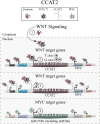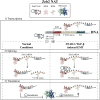An emerging role for long non-coding RNAs in cancer metastasis
- PMID: 25101115
- PMCID: PMC4103511
- DOI: 10.3389/fgene.2014.00234
An emerging role for long non-coding RNAs in cancer metastasis
Abstract
Metastasis is a multistep process beginning with the dissemination of tumor cells from a primary site and leading to secondary tumor development in an anatomically distant location. Although significant progress has been made in understanding the molecular characteristics of metastasis, many questions remain regarding the intracellular mechanisms governing transition through the various metastatic stages. Long non-coding RNAs (lncRNAs) are capable of modulating both transcriptional and post-transcriptional regulation, and thus, coordinating a wide array of diverse cellular processes. Current evidence indicates that lncRNAs may also play a crucial role in the metastatic process through regulation of metastatic signaling cascades as well as interaction with specific metastatic factors. Here we summarize a subset of lncRNAs with proposed roles in metastasis and, when applicable, highlight the mechanism by which they function.
Keywords: cancer; epithelial-mesenchymal-transition; lncRNA; metastasis; non-coding RNA.
Figures





References
Publication types
LinkOut - more resources
Full Text Sources
Other Literature Sources

